Every big brand has a style guide, sort of a Ten Commandments. One commandment is the brand colors, and from it thou shall not deviate. They include at least one primary color and a set of secondary colors with corresponding HEX, RGB, CBYK codes.
Take a look at the Parliament box—the two blues are the brand
’s primary colors, the silver a primary secondary, and the red dot of the P a distant secondary. They evolved from the gold and single dark blue of the original brand
. Creatives assigned to refresh Parliament products can play around with them—for example, reversing the primary blues for the secondary silver or bringing back the original gold—but they shouldn’t rely on colors outside of these specific blues, this specific red, unless they want to break the commandments.
Humans didn’t make up branding, we stole it from nature. Animals/plants, secondary/tertiary colors. The secondary mustard of the iris flower. The spikey curves of the Joshua tree versus the right angles of the saguaro. The rounder snout of the crocodile compared to the alligator’s u-shaped smile.
I’ve only had one profound psychedelic experience. Bobbling around the Joshua Trees attempting, and failing, to have my mind blown, I returned to my group of friends puffing away under an umbrella. Next to some wounded soldiers sat two packs of cigarettes. On the left, American Spirits, the matte yellow like the skin of a banana. On the right, Parliaments, blue and white like a first place ribbon.
For a moment, the colors became textures and the logos became language. I experienced a feeling of overwhelming understanding, acceptance, and gratitude about the way things are. What I recognized is impossible to put into words, and even if it were I’m not the guy to do it. The best I can do is to say that noticing the differences between similar things creates good feelings in human beings.

“…and God is one” is a key phrase of the Shema, the central prayer in all Judaism. Rabbi Aryeh Perlstein
unpacks it thusly.
“People can’t create something from nothing, we’re all curators of existing molecules, constructs, ideas, etc. Therefore, every thing is constantly being created or sustained by God’s divine energy. When a pagan worships the forest, he is worshipping only a part of God; a manifestation of God’s will. He’s getting stuck at the glitz without getting any of the glam. He’s going for what’s relatable, what’s convenient—even what’s controllable. It would be like someone loving you for your shirt. Your shirt may be an expression of you, but it is not you. Much better to love the whole God, not just one of His shirts.”
While worshipping God’s shirt is wrong, enjoying it is right, and that’s about understanding why it is the way it is in comparison to other things like it. This is the meaning of branding. If every thing is God’s will, then the differences between them are God’s language. Cormac McCarthy wrote, “God speaks in stones and trees, the bones of things." When nature brands a spider with a red hourglass
, we feel like we’ve received a carefully considered gift. And perhaps we have. But if all spiders had the symbol we wouldn’t feel connected to anything greater.
The bombardier beetle shoots fire, the hornet stabs with a dagger, the bee stabs and sacrifices himself. Why does just knowing these things bring us such pleasure?
For the same reason sneakerheads love contemplating the difference between Jordan 1 and Jordan 3
. The divine is no more complicated than the medium by which our attempts at creation are measured. It tells us “yes,” “no,” “stronger,” “deeper blues”, and we listen, and we respond. If we don’t respond, we’re shitty creatives.
I remember my first day at a legitimate branding agency. In a conference room, every inch of wall was covered with variations on a single logo. As a writer, it felt pedantic at first. A fundamental rule of ad writing is never send the clients tweaked variations of the same line. Never ever present “we serve restaurants,
” “we serve up restaurants,” “serving restaurants,” and “we live to serve restaurants,” to the same client at the same time. It’s bush league.
But brands are not their taglines. Words tell stories, but branding is closer to nature. Goethe said, “Even the unnatural, that too is natural.” A building is a termite mound. A billboard is a tree.
Nature wears God’s brands far better than we ever could. But, like an assembly line of Santa’s gnomes, we’re part of the workshop. In a world where consumption is expression, brands express something we can’t say. So next time you’re staring down the paper towel aisle, be less depressed—you’re reading a conversation with God.
